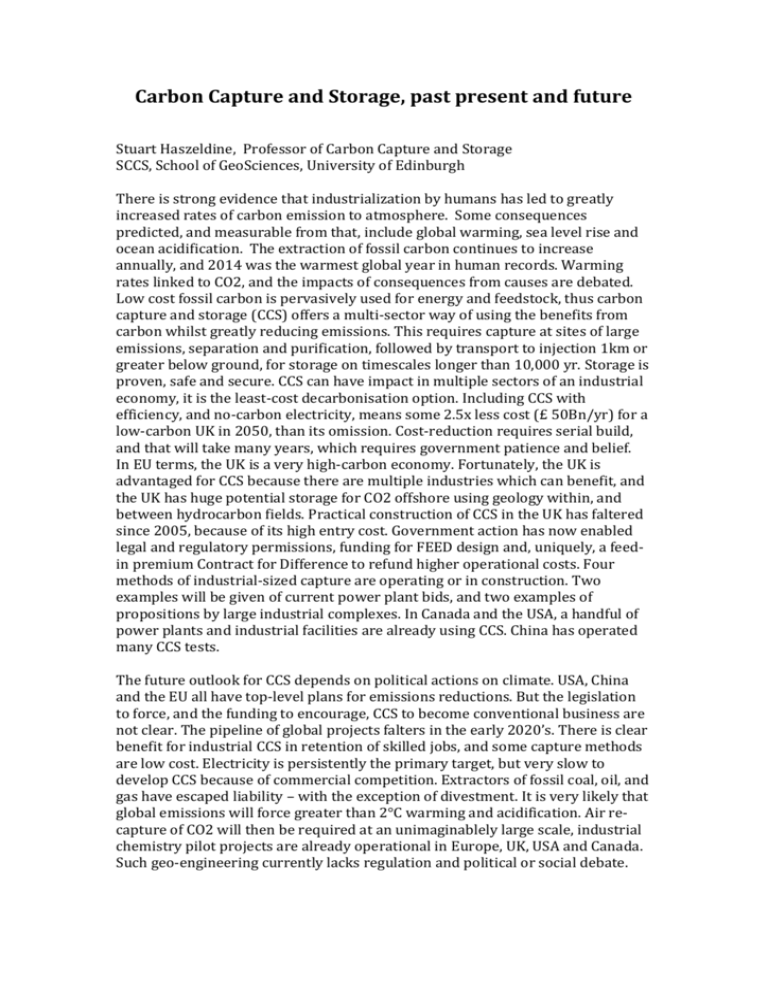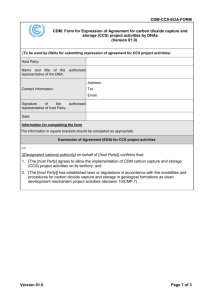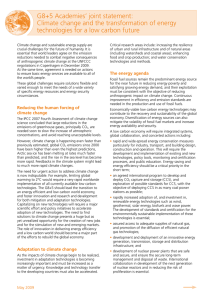Carbon capture and storage
advertisement

Carbon Capture and Storage, past present and future Stuart Haszeldine, Professor of Carbon Capture and Storage SCCS, School of GeoSciences, University of Edinburgh There is strong evidence that industrialization by humans has led to greatly increased rates of carbon emission to atmosphere. Some consequences predicted, and measurable from that, include global warming, sea level rise and ocean acidification. The extraction of fossil carbon continues to increase annually, and 2014 was the warmest global year in human records. Warming rates linked to CO2, and the impacts of consequences from causes are debated. Low cost fossil carbon is pervasively used for energy and feedstock, thus carbon capture and storage (CCS) offers a multi-sector way of using the benefits from carbon whilst greatly reducing emissions. This requires capture at sites of large emissions, separation and purification, followed by transport to injection 1km or greater below ground, for storage on timescales longer than 10,000 yr. Storage is proven, safe and secure. CCS can have impact in multiple sectors of an industrial economy, it is the least-cost decarbonisation option. Including CCS with efficiency, and no-carbon electricity, means some 2.5x less cost (£ 50Bn/yr) for a low-carbon UK in 2050, than its omission. Cost-reduction requires serial build, and that will take many years, which requires government patience and belief. In EU terms, the UK is a very high-carbon economy. Fortunately, the UK is advantaged for CCS because there are multiple industries which can benefit, and the UK has huge potential storage for CO2 offshore using geology within, and between hydrocarbon fields. Practical construction of CCS in the UK has faltered since 2005, because of its high entry cost. Government action has now enabled legal and regulatory permissions, funding for FEED design and, uniquely, a feedin premium Contract for Difference to refund higher operational costs. Four methods of industrial-sized capture are operating or in construction. Two examples will be given of current power plant bids, and two examples of propositions by large industrial complexes. In Canada and the USA, a handful of power plants and industrial facilities are already using CCS. China has operated many CCS tests. The future outlook for CCS depends on political actions on climate. USA, China and the EU all have top-level plans for emissions reductions. But the legislation to force, and the funding to encourage, CCS to become conventional business are not clear. The pipeline of global projects falters in the early 2020’s. There is clear benefit for industrial CCS in retention of skilled jobs, and some capture methods are low cost. Electricity is persistently the primary target, but very slow to develop CCS because of commercial competition. Extractors of fossil coal, oil, and gas have escaped liability – with the exception of divestment. It is very likely that global emissions will force greater than 2°C warming and acidification. Air recapture of CO2 will then be required at an unimaginablely large scale, industrial chemistry pilot projects are already operational in Europe, UK, USA and Canada. Such geo-engineering currently lacks regulation and political or social debate.











